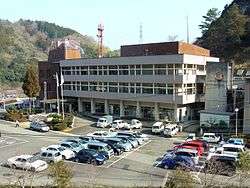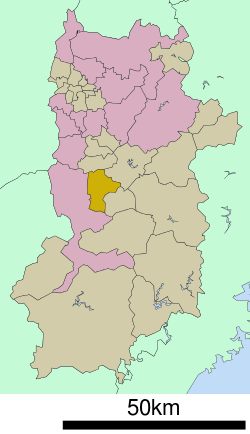Shimoichi, Nara
Shimoichi (下市町, Shimoichi-chō) is a town in Yoshino District, Nara Prefecture, Japan.
Shimoichi 下市町 | |
|---|---|
Town | |
 Shimoichi Town Office | |
Flag Chapter | |
 Location of Shimoichi in Nara Prefecture | |
 Shimoichi Location in Japan | |
| Coordinates: 34°22′N 135°48′E | |
| Country | Japan |
| Region | Kansai |
| Prefecture | Nara Prefecture |
| District | Yoshino |
| Area | |
| • Total | 62.01 km2 (23.94 sq mi) |
| Population (April 1, 2017) | |
| • Total | 5,378 |
| • Density | 87/km2 (220/sq mi) |
| Symbols | |
| • Tree | Pine |
| • Flower | Portulaca pilosa |
| Time zone | UTC+9 (JST) |
| City hall address | 1960 Ōaza Shimoichi, Shimoichi-machi, Nara-ken 638-8510 |
| Website | www |
As of 1 April 2017, the town has an estimated population of 5,378 and a population density of 86.8 persons per km². The total area is 61.99 km².
The town is perhaps most famous for the Tsurube Sushi Shop which is featured in the popular kabuki play Yoshitsune Senbon Zakura. The shop still operates today, and claims to have existed as far back as the 17th century. There are several restaurants and tea houses throughout the town offering sushi, okonomiyaki, udon, takoyaki, and soba.
Shimoichi has many waribashi (disposable chopsticks) factories, onsen, persimmons, shrine ornaments and wood work, bath salt plant, and regional dessert souvenir factory. There are also konnyaku, sōmen, and soba factories.
Shimoichi also has its own television station. Shimoichi-Terebi offers news coverage, local sight-seeing information and tours, as well as various public information; such as fire, earthquake, and storm updates. Shimoichi-terebi offers a large amount of local school coverage for sports and cultural festivals.
Train access
Shimoichi may be reached via Kintetsu Railway on the Minami Osaka Line.
Geography
Shimoichi sits nestled between mountains covered with pine trees and bamboo along the Yoshino River, southwest of Nara City.
Surrounding municipalities
Festivals
Hatsuichi is an annual festival in early February which means "first market". Long ago in Shimoichi before supermarkets and modern conveniences existed, the townspeople would gather every ten days for a market. This started on the first of every month. Hatsuichi marked the first market of the new lunar year. Over time Hatsuichi and Ebisu Shrine joined efforts to form the modern day festival. Ebisu is a business god and one of seven Chinese gods derived from China. Ebisu Shrine is colorfully decorated with illuminated lanterns, traditional shrine ornaments and colors for this event. This festival marks the annual opening of the shrine in which members of the community and visitors may enter and pray for good business. In 2009, Nara's mascot Sento-kun visited the event as the streets were lined with various fair foods, games, door prizes, and plants for sale. On the afternoon of Hatsuichi an annual shrine pulling parade occurs.
In July, the neighboring town of Oyodo will host the Yoshino-gawa festival which includes a dynamic fireworks display and various festival games and foods.
In early October, the town holds a sports festival in honor of Japan's national "Health & Sports Day" holiday. An opening ceremony including fireworks and the lighting of an Olympic style torch takes place as the neighborhoods compete in various games. Door prizes are awarded on the neighborhood and town level, and may include items such as bags of rice, bicycles, toaster ovens, heaters, tissue, beer, game systems, and various household items. The town's schools also participate in the event with various dances and performances.
The Aki Matsuri (Fall Festival) is held in mid to late October. Activities involve a parade of lanterns and drums down the main street until reaching its destination at one of the town's temples which resides near the top of a mountain. The town's bunkasai (cultural festival) also takes place around this time, with numerous performances from townspeople and local schools, as well as calligraphy, pottery, paintings, and flower arrangements from local artists on display around the community's cultural hall.
Education
Shimoichi has one public kindergarten, one elementary, and one junior high school.
The junior high school has over 200 students and about 30 faculty and staff members. Their mascot is the dragonfly. School clubs include volleyball, chorus, brass band, art, shuji (calligraphy), baseball, track and field, English, and table tennis. The chorus club has a 50-year first place winning streak. The baseball club also has a good prefectural reputation and was chosen to participate in a prefectural baseball tournament during the 2007-2008 school year.
The Shimoichi Board of Education is a participant in the JET (Japan Exchange and Teaching) Programme. The JET Programme is a Japanese government initiative which aims to promote internationalization in Japan’s local communities by helping to improve foreign language education and developing international exchange at the community level.[1] Shimoichi has two native English speakers who work as Assistant Language Teachers (ALT). One is placed predominantly at Shimoichi Elementary, while the other is placed at Shimoichi Junior High. The junior high school has had an ALT since 1997, while the elementary school first acquired an ALT in 2006.
History
The area is thought to have been inhabited by the Yamato people since prehistoric times, with archaeological evidence indicating activity in the area as far back as the Jōmon period. What is now the town of Shimoichi has stood as the "entrance to Yoshino" since the Heian period (794-1185), originally known for the predominant market opened in the area. It flourished as the main business district of the Yoshino region, with "Shimoichi bills" being issued as Japan's first commercial bills.
- 1889: Surrounding villages are consolidated and Shimoichi village is established.
- 1890: Shimoichi village becomes Shimoichi town.
- 1956: Akino village and Niu village is merged into Shimoichi town.
- 1958: Shimoichi town crest is established.
- 1982: A change is made to the border with Nishi-yoshino village.
Notable places
- Niukawakami Shrine
- Ryudouin
- Hirobashi Cherry tree Forest
- Gangyō temple
Nearby attractions
- Niukawakami Shrine
- Ryudouin
- Kabutomushi Park
- Shimoichi onsen: includes separate bathing areas for men and women as well as a restaurant.
- Yoshino, Nara: a spring tourist attraction due to its millions of sakura (cherry blossoms). 10 minutes via Shimoichi-guchi Kintetsu train station
- Asuka: 20 minutes to Asuka via Shimoichi-guchi Kintetsu train station
- Kashiharajingu Shrine: 40 minutes to Kashiharajingu-mae via Shimoichi-guchi Kintetsu train station
- Aruru "Diamond City" Aeon Mall: 50 minutes to Yamato-yagi via Shimoichi-guchi Kintetsu train station and Nara Kotsu bus from Yamato-yagi station.
References
- "History | JET Programme". JET Programme. Retrieved 2017-05-18.
External links
| Wikimedia Commons has media related to Shimoichi, Nara. |
- Official website (in Japanese)